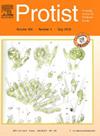Taxonomy and phylogeny of Phialina shanghaiensis sp. nov. and Lacrymaria filiformis (Maskell, 1886) Foissner, 1983 (Ciliophora, Litostomatea, Haptoria) from Changjiang Estuary, China
IF 2.1
3区 生物学
Q4 MICROBIOLOGY
引用次数: 0
Abstract
Lacrymaria and Phialina are two closely related genera within Haptoria, yet the morphology and taxonomic affiliations of most species remain enigmatic. In the present study, we isolated two lacrymariid species, Phialina shanghaiensis sp. nov. and Lacrymaria filiformis (Maskell, 1886) Foissner, 1983 from the Nanhui Wetland, Shanghai, China. Their morphology and phylogeny were investigated using live observation, protargol staining, and SSU rRNA gene sequencing. P. shanghaiensis sp. nov., is primarily distinguished from its congeners by its body size (100–125 × 20–30 μm in vivo), and possessing 12–15 somatic kineties, one macronucleus, and single terminally located contractile vacuole. The Chinese population of L. filiformis is also described in detail, which is characterized by 11–15 somatic kineties, one macronucleus, and a terminally located contractile vacuole. Phylogenetic analyses based on SSU rDNA sequences show that neither Phialina nor Lacrymaria is monophyletic, and the sequences of P. salinarum deposited in GenBank are likely from different salinarum-like species.
长江口海燕(philalina shanghaiensis sp. 11 .)和泪maria filiformis (Maskell, 1886)的分类和系统发育。Foissner, 1983 (Ciliophora, Litostomatea, Haptoria)
泪属(Lacrymaria)和泪属(phalina)是泪属(Haptoria)中两个关系密切的属,但大多数物种的形态和分类归属仍然是一个谜。本研究从上海南汇湿地分离到两种泪科昆虫,即上海泪科(philalina shanghaiensis sp. 11 .)和filformis (Maskell, 1886) Foissner(1983)。采用活体观察、原targol染色和SSU rRNA基因测序等方法研究其形态和系统发育。P. shanghaiensis sp. nov.的主要区别在于其体大小(体内100-125 × 20-30 μm),具有12-15个体细胞动力学,一个巨核和一个末端位置的收缩液泡。本文还详细描述了中国丝状草居群的特征,该居群具有11-15个体细胞动力学,1个巨核和一个位于末端的收缩液泡。基于SSU rDNA序列的系统发育分析表明,phalina和Lacrymaria都不是单系的,GenBank中P. salinarum的序列可能来自不同的类盐种。
本文章由计算机程序翻译,如有差异,请以英文原文为准。
求助全文
约1分钟内获得全文
求助全文
来源期刊

Protist
生物-微生物学
CiteScore
3.60
自引率
4.00%
发文量
43
审稿时长
18.7 weeks
期刊介绍:
Protist is the international forum for reporting substantial and novel findings in any area of research on protists. The criteria for acceptance of manuscripts are scientific excellence, significance, and interest for a broad readership. Suitable subject areas include: molecular, cell and developmental biology, biochemistry, systematics and phylogeny, and ecology of protists. Both autotrophic and heterotrophic protists as well as parasites are covered. The journal publishes original papers, short historical perspectives and includes a news and views section.
 求助内容:
求助内容: 应助结果提醒方式:
应助结果提醒方式:


